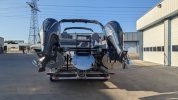Jgedeon
Well-Known Member
All very true. The other two Benningtons have not been wide beams with single motors and it was easy to get the transducer to work at cruising speed for depth. One was an I/O, still love my I/O's for water sports, the other was a single outboard.Just keep in mind it's not depth necessarily that you're looking for, it's clean water. That may or may not improve with depth and may require shifting side to side as well. If there is an anode on the bracket consider relocating as this will cause turbulence. Also something to consider is beaching the boat - there are times when I like to back in the stern to shore and the tducer will take the brunt of it. Make sure if it's mounted at or below the toon's bottom it can flex or slip in it's mounting knuckle so it doesn't break.
Our new boat is a 30 QSBWAx2 wide beam and looking at what Bennington on other wide beam models has designed and where they have mounted the transducer IMHO is just a poor untested design. I looked at an earlier version and 27' QX model and the one mounting bracket welded to the center toon was a little lower than our but still had the same issue. Couldn't get in the water and clean water at speed.
The current set up of the ladder doesn't allow something at the lower section of the center toon for mounting of the transducer. Maybe if the Lilly-Pad ladder was default on these models there would be enough space for a mounting location and decent transducer but current design needs to be rethought out. I have attach an image of our current boat so that it's easy to see. You can see how quickly and easy it is to get the transducer either in dirty water or even out of the water. Don't get me wrong, we still love out new boat.

